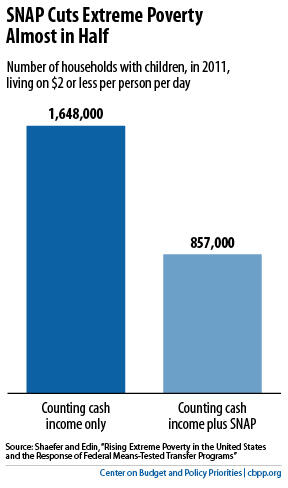BEYOND THE NUMBERS
Even as the House prepares this week to cut SNAP (formerly food stamps) by $21 billion and push 2 million low-income people off the program, new research shows that SNAP is the most effective program pushing against the steep rise in extreme poverty.

While these findings are troubling, the authors also show that SNAP kept more households with children out of extreme poverty than any other government program.
Counting SNAP benefits as income cuts the number of households with children in extreme poverty in 2011 by 48 percent, from 1.6 million to 857,000 (see graph).
SNAP also cut, by roughly half, the rise in extreme poverty among households with children between 1996 and 2011, the study found.
The study provides strong evidence that one of the main drivers of rising extreme poverty was the decline in cash assistance since the 1996 welfare reform. Aid to Families with Dependent Children (AFDC) cut extreme poverty significantly in 1996, the study found, but Temporary Assistance to Needy Families (TANF) — which replaced AFDC after 1996 and reaches many fewer needy families — had a much smaller impact in 2011.
For many of the poorest Americans, SNAP has become the only form of income assistance they receive.
One reason SNAP is so effective in fighting extreme poverty is that it focuses its benefits on many of the poorest households. Roughly 91 percent of monthly SNAP benefits go to households below the poverty line, and 55 percent go to households below half of the poverty line (about $9,800 for a family of three). One in five SNAP households lives on cash income of less than $2 per person a day.
The farm bill before the House would move SNAP in the wrong direction by cutting or eliminating food assistance to large numbers of low-income families.
